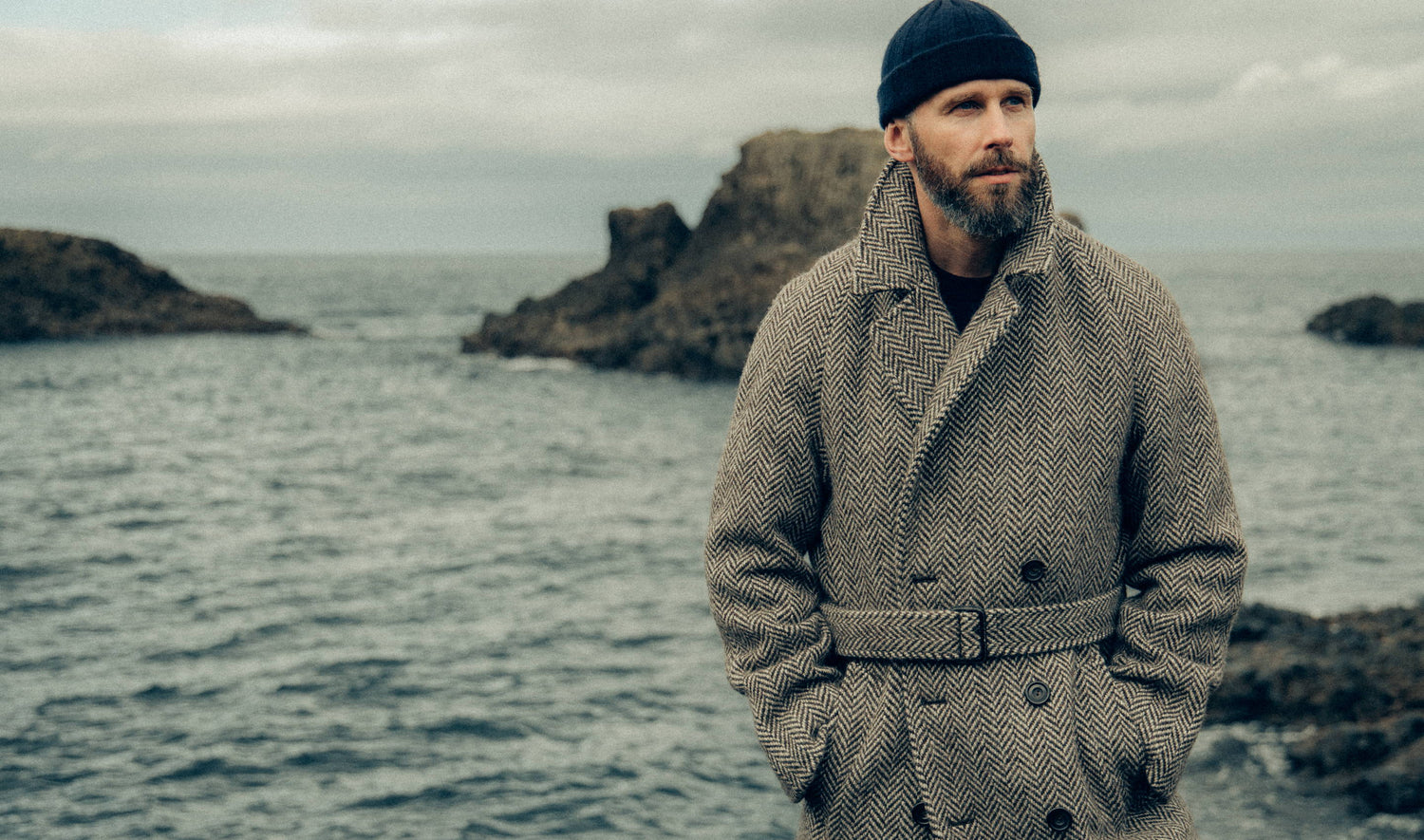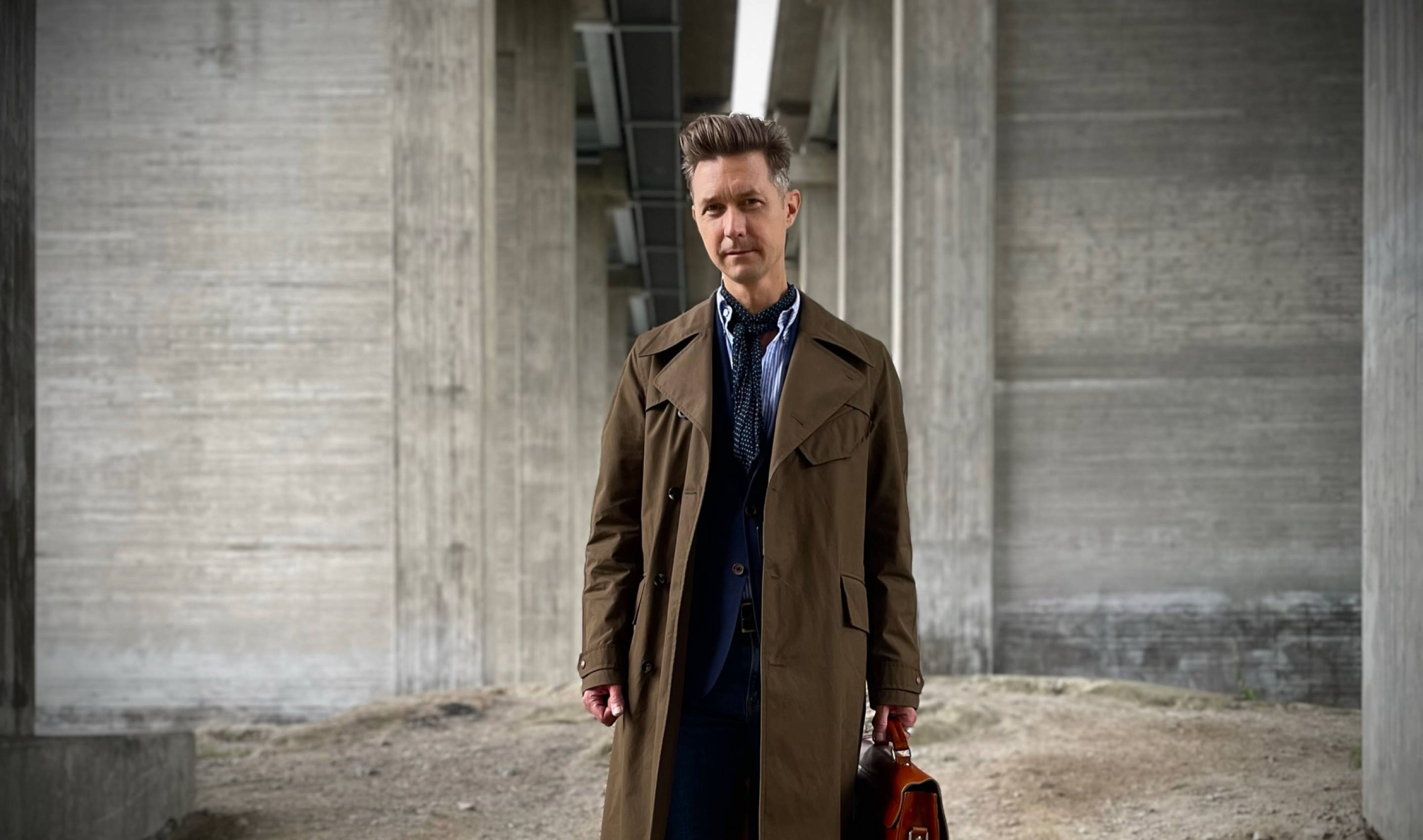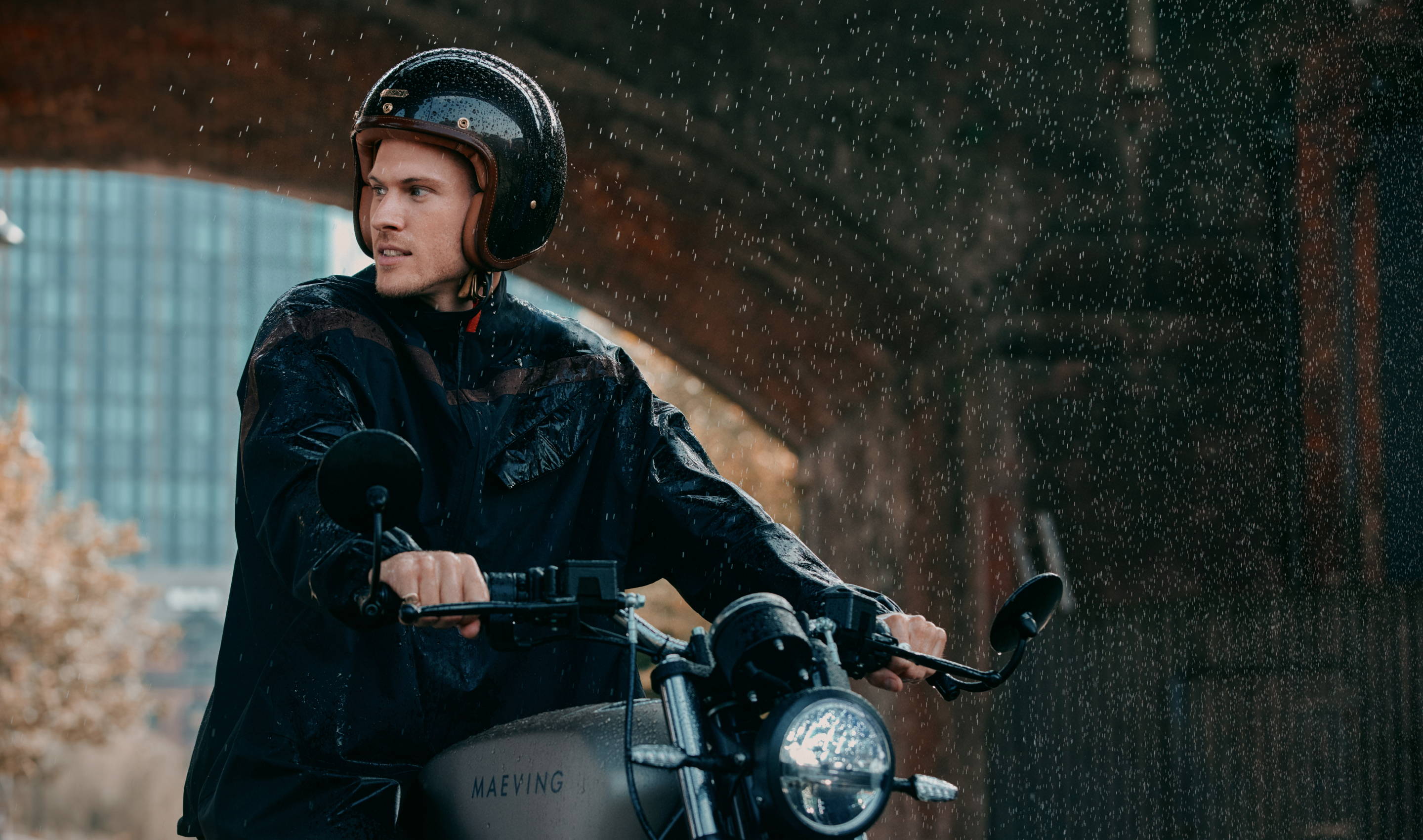Words by Simon Crompton
Imagery by Jamie Ferguson
“Oh, that is cosy.”
“It's like being wrapped up in a big tweedy blanket.”
“I could fall asleep in the corner like this.”
I’ve never done a pop-up where I had the sample of a new release for people to try on, and could see their reactions. In New York last month I did, and those were some of the first things people said when they put on this, our new ‘English Tweed’ overcoat.
I thought these specific reactions were interesting because they highlight a key difference between this and the PS Donegal. This is a thick, cosy, winter overcoat. It’s something to wrap yourself up in, to feel cocooned, to step out into the cold when you can see your breath.
Words by Simon Crompton
Imagery by Jamie Ferguson
“Oh, that is cosy.”
“It's like being wrapped up in a big tweedy blanket.”
“I could fall asleep in the corner like this.”
I’ve never done a pop-up where I had the sample of a new release for people to try on, and could see their reactions. In New York last month I did, and those were some of the first things people said when they put on this, our new ‘English Tweed’ overcoat.
I thought these specific reactions were interesting because they highlight a key difference between this and the PS Donegal. This is a thick, cosy, winter overcoat. It’s something to wrap yourself up in, to feel cocooned, to step out into the cold when you can see your breath.
We’ve never done a real winter coat on PS so it was something I wanted to do this year. Inspiration came when I found an old British model from 1980 in a vintage store. It was large, slouchy, with a frighteningly low buttoning point and a droopy collar. It was a little too much for today - a little too period - but with some updates it has inspired something really unique and modern.
The coat is still big. Big back, long body, generous sleeve. It fits over everything, cinches in the warmth, and buttons all the way up to the chin. But we moderated that collar shape, so it now has a pleasing line that runs along the edge of the collar and then all the way down the lapel (below).
Then with hands in the coat pockets, it also has a beautiful shape to the front. You can see that in the image above: long lines from each lapel, stitched to keep them long and straight.
But you can also button or belt it in several ways. The buttoning point (the middle of the three) is still fairly low - one of the things that gives the coat more than a little of a louche Armani feel.
You can fasten it there, with the belt secured at the back, and go on your way (below left). Or you can do the opposite, and just use the belt: cinching it across those long open lapels and giving it a thrown-on robe look (below right).
This is what I love about a loose, unstructured double-breasted coat: this playfulness and ease.
You don’t get it so much with tailored overcoats, but you do with a classic raincoat: there are so many ways to wear it, so much personality you can give it.
On the belt, it’s important to note that it doesn’t have a prong or holes. It’s so thick it doesn’t need them. Instead, you put the belt through the buckle and pull it back on itself, tucking it either in the loop at the side or through itself.
I find this really satisfying - less fussy and simpler than knotting. In fact it’s a good way to secure the belt at the back too, if you don’t want to use it. Pull the buckle to one side, then put the other end through the opposite loop, back through the buckle, and tuck it in.
I’ve included a few images at the bottom of these various beltings and buttonings, as I knew readers would ask. But I can do a more explicit article at some point if that’s helpful.
OK let’s talk about the cloth, as it's beautiful and just as significant to how the English Tweed overcoat is different to the Donegal.
This material is heavier, tweedier and spongier. It weighs 800g compared to the 720g of the Donegal, but feels much warmer because of the open way it’s woven - more like a tweed - as well as the double fronts and belt.
Which gets us to the name. I thought ‘English Tweed’ was nice because it recalls all the English aspects that make it up. It uses undyed wool from English sheep - the dark-brown, cream and grey yarns you can see in it are the natural colours of the sheep themselves.
It was spun in England, and that yarn was woven by Marling & Evans in Huddersfield - before being assembled by Private White V.C. down the road in Manchester. Add the fact that it was designed by us in London, using a piece of English vintage as inspiration, and you have a very Anglo creation. If there were such a thing as an English tweed, this would be it.
In fact there’s a remarkable story about that vintage piece that inspired it, and its connection to PWVC and M&E, but I might save that for a later date. There are too many questions buzzing around my head that I know readers will be asking.
So this coat is clearly different in style, in weight, in season from the Donegal. But given the patterns are fairly similar (smaller herringbone, dark brown rather than black, different texture, but still) do I think a reader could own both?
Many readers, yes. I have both and love both - I wouldn’t want to give up either. I also know a lot of readers will have just one or two good coats though, and are only beginning on building a good wardrobe. For them, I can see they might not want both. For everyone else, I think they’d enjoy both.
And of course many readers don’t have that particular Donegal, have it in other colours, or indeed (shockingly) own no Donegal at all.
I think this slouchy, low-slung slice of classic menswear looks best in a brown-and-grey herringbone. It suits the classic-but-casual look, as well as the echoes of early eighties style. As ever, the aim of the PS Shop is to produce beautiful unique pieces, rather than fill out a wardrobe or a ‘collection’.
Let’s summarise the other design elements. Some will be familiar to readers from other coats, but some are a little different:
- Cashmere-lined pockets. (So satisfying to plunge your hands in on a cold day.)
- And they're through pockets, with access to big buckets on the inside - as shown above. (That’s where my gloves go, or a hat.)
- Two slanted pockets behind the lapels. (For easy access to phone, wallet etc.)
- Wrist straps to narrow the sleeve against the cold. (I also find I keep them wider when I'm wearing a jacket underneath.)
- Stand-up collar. (With crescent inserted on the back so it actually stands.)
- Two-hole matte horn buttons. (Interesting how I’ve seen this cropping up around the place now.)
As with the best menswear, pretty much all form through function.
I’ve shown the coat here with a range of outfits, to illustrate how it works with a suit and tie, and a T-shirt and jeans.
The first outfit is a navy knit and black jeans, though the latter could easily be charcoal flannels for something smarter. Then there’s a brown suit with a white shirt and tie, and without the tie. And lastly a white T-shirt, blue jeans and loafers - the most casual of the lot.
Like the recently released raincoat, it’s very satisfying to be able to wear a coat this casually. (Even if the weather would mean I'd usually wear it with a hoodie or sweatshirt, rather than just a T-shirt.)
It’s not hard for a brand to make a DB coat. They find an old image, give it to a factory, pick a stock cloth and put it on e-comm. But without good design, the factory could make the sleeve too slim, or put the belt too high, or shorten the length because it’s what ‘everyone’ is doing.
Good design is about thinking through every aspect of a piece like a DB, and making conscious aesthetic choices. That's what makes a piece feel different when you put it on, and why it remains a favourite after five, 10, 20 years of wear. It becomes the piece you look forward to wearing every season, and even a reference for everyone else.
We’ve never done a real winter coat on PS so it was something I wanted to do this year. Inspiration came when I found an old British model from 1980 in a vintage store. It was large, slouchy, with a frighteningly low buttoning point and a droopy collar. It was a little too much for today - a little too period - but with some updates it has inspired something really unique and modern.
The coat is still big. Big back, long body, generous sleeve. It fits over everything, cinches in the warmth, and buttons all the way up to the chin. But we moderated that collar shape, so it now has a pleasing line that runs along the edge of the collar and then all the way down the lapel (below).
I’m not going to say that’s what our new coat necessarily is - that’s for readers to decide - but in an age when there are lots of brands selling lots of coats, all self-referencing and even undercutting each other, it’s good design that really stands out. That plus quality are what are worth the money in the long run.
The English Tweed overcoat, wonderfully made by Private White V.C. in Manchester, is available now here.
Details:
- Low-slung, slouchy double-breasted raglan coat
- Made from undyed English wool, woven in Huddersfield by Marling & Evans
- Belt with leather buckle, unholed to double back on itself
- Two-hole matte horn buttons
- Cashmere-lined hip pockets, both with through pockets to larger pockets inside
- Two inbreast slanted pockets
- Manufactured by Private White V.C. in Manchester
Fit:
- A generous body fit and length, designed to be cinched for warmth
- In the pictures Simon wears a Medium (4)
- He wears a size 40 (50 European) suit jacket and is six feet tall (183cm)
- Fits the same size as other Private White-made outerwear (apart perhaps from the Bridge Coat)
- If in doubt, compare measurements to a coat you already own, bearing in mind the fit is meant to be generous. Don’t worry if it looks or feels a little big
- Chest is measured 2.5cm below underarm; waist at 47cm down centre back; length from bottom of collar at the back, to hem
THE PERMANENT STYLE ENGLISH TWEED OVERCOAT
Then with hands in the coat pockets, it also has a beautiful shape to the front. You can see that in the image above: long lines from each lapel, stitched to keep them long and straight.
But you can also button or belt it in several ways. The buttoning point (the middle of the three) is still fairly low - one of the things that gives the coat more than a little of a louche Armani feel.
You can fasten it there, with the belt secured at the back, and go on your way (first image). Or you can do the opposite, and just use the belt: cinching it across those long open lapels and giving it a thrown-on robe look (second image).
This is what I love about a loose, unstructured double-breasted coat: this playfulness and ease.
You don’t get it so much with tailored overcoats, but you do with a classic raincoat: there are so many ways to wear it, so much personality you can give it.
On the belt, it’s important to note that it doesn’t have a prong or holes. It’s so thick it doesn’t need them. Instead, you put the belt through the buckle and pull it back on itself, tucking it either in the loop at the side or through itself.
I find this really satisfying - less fussy and simpler than knotting. In fact it’s a good way to secure the belt at the back too, if you don’t want to use it. Pull the buckle to one side, then put the other end through the opposite loop, back through the buckle, and tuck it in.
I’ve included a few images at the bottom of these various beltings and buttonings, as I knew readers would ask. But I can do a more explicit article at some point if that’s helpful.
OK let’s talk about the cloth, as it's beautiful and just as significant to how the English Tweed overcoat is different to the Donegal.
This material is heavier, tweedier and spongier. It weighs 800g compared to the 720g of the Donegal, but feels much warmer because of the open way it’s woven - more like a tweed - as well as the double fronts and belt.
Which gets us to the name. I thought ‘English Tweed’ was nice because it recalls all the English aspects that make it up. It uses undyed wool from English sheep - the dark-brown, cream and grey yarns you can see in it are the natural colours of the sheep themselves.
It was spun in England, and that yarn was woven by Marling & Evans in Huddersfield - before being assembled by Private White V.C. down the road in Manchester. Add the fact that it was designed by us in London, using a piece of English vintage as inspiration, and you have a very Anglo creation. If there were such a thing as an English tweed, this would be it.
In fact there’s a remarkable story about that vintage piece that inspired it, and its connection to PWVC and M&E, but I might save that for a later date. There are too many questions buzzing around my head that I know readers will be asking.
So this coat is clearly different in style, in weight, in season from the Donegal. But given the patterns are fairly similar (smaller herringbone, dark brown rather than black, different texture, but still) do I think a reader could own both?
Many readers, yes. I have both and love both - I wouldn’t want to give up either. I also know a lot of readers will have just one or two good coats though, and are only beginning on building a good wardrobe. For them, I can see they might not want both. For everyone else, I think they’d enjoy both.
And of course many readers don’t have that particular Donegal, have it in other colours, or indeed (shockingly) own no Donegal at all.
I think this slouchy, low-slung slice of classic menswear looks best in a brown-and-grey herringbone. It suits the classic-but-casual look, as well as the echoes of early eighties style. As ever, the aim of the PS Shop is to produce beautiful unique pieces, rather than fill out a wardrobe or a ‘collection’.
Let’s summarise the other design elements. Some will be familiar to readers from other coats, but some are a little different:
- Cashmere-lined pockets. (So satisfying to plunge your hands in on a cold day.)
- And they're through pockets, with access to big buckets on the inside - as shown above. (That’s where my gloves go, or a hat.)
- Two slanted pockets behind the lapels. (For easy access to phone, wallet etc.)
- Wrist straps to narrow the sleeve against the cold. (I also find I keep them wider when I'm wearing a jacket underneath.)
- Stand-up collar. (With crescent inserted on the back so it actually stands.)
- Two-hole matte horn buttons. (Interesting how I’ve seen this cropping up around the place now.)
As with the best menswear, pretty much all form through function.
I’ve shown the coat here with a range of outfits, to illustrate how it works with a suit and tie, and a T-shirt and jeans.
The first outfit is a navy knit and black jeans, though the latter could easily be charcoal flannels for something smarter. Then there’s a brown suit with a white shirt and tie, and without the tie. And lastly a white T-shirt, blue jeans and loafers - the most casual of the lot.
Like the recently released raincoat, it’s very satisfying to be able to wear a coat this casually. (Even if the weather would mean I'd usually wear it with a hoodie or sweatshirt, rather than just a T-shirt.)
It’s not hard for a brand to make a DB coat. They find an old image, give it to a factory, pick a stock cloth and put it on e-comm. But without good design, the factory could make the sleeve too slim, or put the belt too high, or shorten the length because it’s what ‘everyone’ is doing.
Good design is about thinking through every aspect of a piece like a DB, and making conscious aesthetic choices. That's what makes a piece feel different when you put it on, and why it remains a favourite after five, 10, 20 years of wear. It becomes the piece you look forward to wearing every season, and even a reference for everyone else.
I’m not going to say that’s what our new coat necessarily is - that’s for readers to decide - but in an age when there are lots of brands selling lots of coats, all self-referencing and even undercutting each other, it’s good design that really stands out. That plus quality are what are worth the money in the long run.
The English Tweed overcoat, wonderfully made by Private White V.C. in Manchester, is available now here.
Details:
- Low-slung, slouchy double-breasted raglan coat
- Made from undyed English wool, woven in Huddersfield by Marling & Evans
- Belt with leather buckle, unholed to double back on itself
- Two-hole matte horn buttons
- Cashmere-lined hip pockets, both with through pockets to larger pockets inside
- Two inbreast slanted pockets
- Manufactured by Private White V.C. in Manchester
Fit:
- A generous body fit and length, designed to be cinched for warmth
- In the pictures Simon wears a Medium (4)
He wears a size 40 (50 European) suit jacket and is six feet tall (183cm) - Fits the same size as other Private White-made outerwear (apart perhaps from the Bridge Coat)
- If in doubt, compare measurements to a coat you already own, bearing in mind the fit is meant to be generous. Don’t worry if it looks or feels a little big
- Chest is measured 2.5cm below underarm; waist at 47cm down centre back; length from bottom of collar at the back, to hem






Leave a comment
This site is protected by hCaptcha and the hCaptcha Privacy Policy and Terms of Service apply.